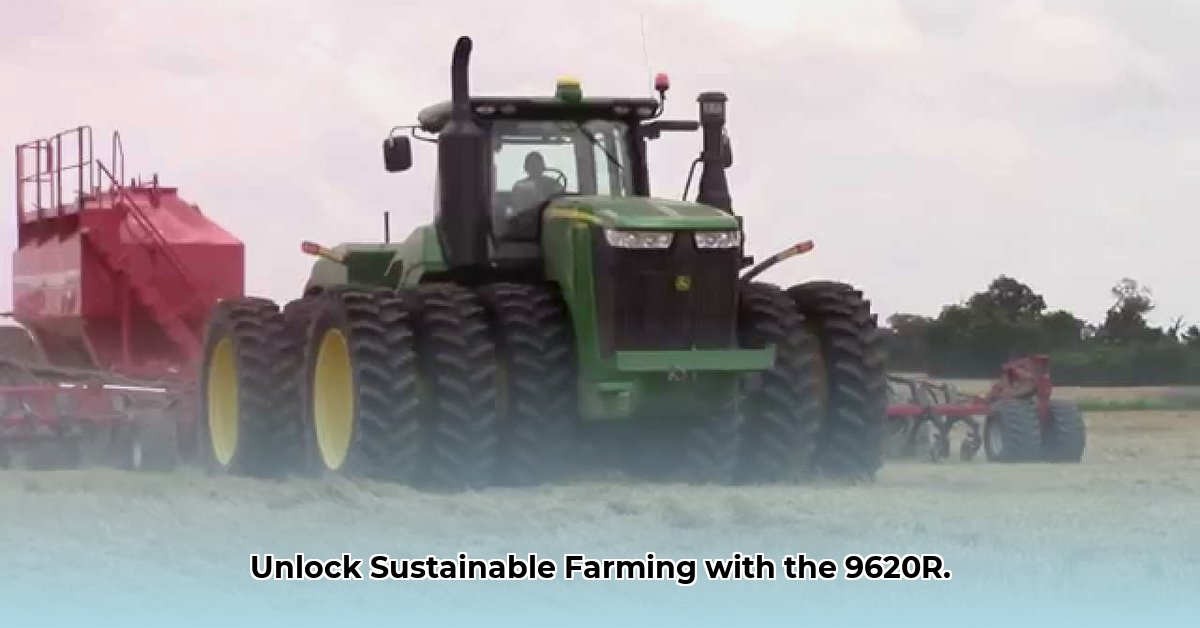
The John Deere 9620R 4WD tractor, with its impressive 620 horsepower engine, represents a significant investment for any farm. But its power comes with a responsibility: how can we harness this capability within the framework of sustainable agriculture? This case study examines the 9620R's role in sustainable farming, exploring its technological advantages, fuel efficiency considerations, and broader environmental impacts. We’ll also provide actionable steps for farmers, manufacturers, and policymakers to optimize sustainability. For more information on John Deere tractors, check out available deals.
Harnessing Technology for Enhanced Sustainability
The 9620R's technological features are crucial for optimizing its contribution to sustainable practices. AutoTrac, the GPS-guided steering system, ensures precise field operations, minimizing overlaps and reducing fuel consumption. This precision is fundamental to variable rate technology (VRT), enabling the targeted application of fertilizers, pesticides, and seeds, thereby reducing waste and environmental impact. JDLink, the remote monitoring system, provides real-time data on the tractor's performance, allowing for proactive maintenance and adjustments, further optimizing fuel efficiency. However, realizing the full potential of these features requires farmer training and commitment to best practices. Does this technological investment justify the cost? The answer depends on factors like farm size, cropping systems, and the farmer’s commitment to precision agriculture.
Fuel Efficiency: A Critical Consideration
The 9620R's substantial 400-gallon fuel tank highlights a key challenge: its considerable fuel consumption. High fuel usage translates directly to increased greenhouse gas emissions and higher operating costs. How can we mitigate this? Several strategies are crucial. Optimizing tractor settings (selecting appropriate power modes), maintaining proper tire pressure (to minimize rolling resistance), and employing smooth operating techniques (avoiding jerky movements) are essential steps. Furthermore, integrating precision farming practices ensures efficient field coverage, directly reducing fuel consumption. While alternative fuels are a future possibility, their current availability and cost-effectiveness might limit their immediate practicality for many farmers. Is the increased productivity of the 9620R worth the additional fuel costs and environmental consequences? A cost-benefit analysis specific to individual farm operations is necessary to answer this question.
Beyond Fuel: Minimizing the Environmental Footprint
The 9620R's impact extends beyond fuel consumption. The potential for soil compaction from heavy machinery is a significant concern; this can negatively affect water infiltration and long-term soil health. Mitigation strategies include employing conservation tillage techniques (minimizing soil disturbance), utilizing appropriate tire pressures to reduce compaction, and optimizing field traffic patterns. Furthermore, adopting broader sustainable agricultural practices, such as crop rotation, cover cropping, and integrated pest management, are equally important for minimizing the overall environmental footprint. These methods can reduce the reliance on intensive tractor use, ultimately lowering the environmental impact. Is it possible to achieve a balance between high productivity and environmental protection? The answer lies in a holistic approach.
Actionable Steps for a Sustainable Future
Achieving sustainable agriculture demands a collaborative effort among various stakeholders.
| Stakeholder | Short-Term Actions | Long-Term Goals |
|---|---|---|
| Farmers | Optimize tractor use (power mode selection, tire pressure); Implement precision farming techniques | Invest in sustainable farming practices; explore carbon sequestration methods; adopt alternative fuels |
| Manufacturers | Improve fuel efficiency; enhance precision technology; explore electrification | Design and manufacture electric/hybrid tractors; use sustainable materials in production |
| Policymakers/Governments | Provide incentives for fuel-efficient and precision farming methods; fund sustainable agriculture research | Implement stricter emission standards; invest heavily in sustainable farming tech R&D |
Mitigating Risks Associated with High-Horsepower Tractors
High-horsepower tractors like the 9620R present certain risks:
| Risk Factor | Risk Level | Mitigation Strategies |
|---|---|---|
| High Fuel Consumption | High | Optimize tractor usage; improve engine efficiency; explore alternative fuels |
| Soil Compaction | Moderate | Careful tire pressure adjustments; employ conservation tillage techniques |
| Greenhouse Gas Emissions | High | Reduce emissions through optimized fuel use and sustainable farming practices |
Conclusion: A Path Towards Sustainability
The John Deere 9620R is a powerful tool capable of significant productivity gains. However, integrating it into a sustainable farming system requires a holistic approach that considers fuel efficiency, soil health, and broader environmental impact. Through the adoption of precision agriculture techniques, strategic management practices, and collaboration among stakeholders, the 9620R can be a valuable asset in creating a more sustainable and environmentally responsible agricultural future. Continuous research, development, and innovation will be crucial in further optimizing the environmental performance of high-horsepower tractors.